< BACK TO INSIGHTS
Insight
Insurance Inclusion Means Remembering the Non-digital Natives
There’s no doubt that technology has simplified the lives of countless consumers, whether making e-commerce purchases, making payments from their phones or trading stock.
Technology has provided customers with more choices and control over their buying decisions across many sectors, and for those who are comfortable with the format, it’s never been simpler.
Personal lines insurance is no different.
Consumers have been demanding that the insurance industry embrace similar technological advancements to enable ease of use and facilitate their customer journeys. As proof that digitization drives significant improvements in the customer experience, employee experience and operational efficiency, consider that today 29% of people prefer to purchase life insurance through an online form, representing an 8% percent increase since 2011, according to RetireGuide®.
In the case of the personal insurance industry, companies are starting to take stock of these trends by ramping up investments in customer-oriented digital capabilities including sleek customer portals, real-time claims trackers, paperless reporting, personalized risk management and chatbots.
While these infrastructural investments represent a good starting place for insurers, they do not serve as a complete substitute for where the industry is going. As customers become more tech savvy and technology continues to advance and becomes easier to use, personal insurance may need to shift away from an agency model toward an online and direct-to-consumer (D2C) model.
What certain customer segments would value even more is a multi-channel model: Older and more vulnerable populations in particular still consider personal interactions of prime importance.
We see the direct-to-consumer trend happening en masse across other industries such as travel, retail and manufacturing. In the case of travel, direct online bookings now dominate the industry’s market share. As of 2020, 65% of revenue in the global travel and tourism market came from online sales channels.
This dynamic, when applied to the personal insurance industry, represents a looming problem for those customers who rely on agents for their insurance needs. The largest impact will be on older customers who may be less tech savvy and customers with disabilities preventing them from using digital channels. As insurers continue to advance in their digital journey, here are some ways that business and digital leaders can work to ensure digital inclusion.
Read the full article here.






